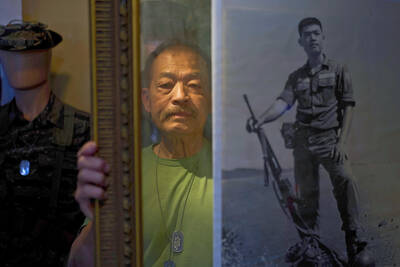By virtue of its picturesque mountains alone, Meinung (美濃) township is worth a visit. Shortly after arriving on a warm summer afternoon, I watched the clouds and mist roll in and shroud the peaks, constantly shifting with the whims of a moody storm. It looked like a slide show of Chinese landscape paintings. By sunset, the skies cleared into hues of pinks and blue, leaving just enough time for a leisurely bicycle ride.
Provided there’s good weather, bicycling remains the best way to explore this popular traditional Hakka town. Most of the historical sites downtown can easily be covered within a day or two. Pleasing sites include the East Gate (東門樓) and Zhongzheng Lake (中正胡), which die-hard Meinung residents refer to as Meinung Lake (美濃胡).
Meinung has a set of color-coded bike paths that take you through many of its smaller roads. Though some of the lines aren’t very clearly marked, don’t worry about getting lost — the mountains should keep you oriented, or listen for the sound of cars to get back on to the main road.
Part of the fun, however, can be losing your way, as you soak in the sights of rice paddies, palm trees and running brooks. You’ll catch an occasional whiff of manure (you’re in the country after all) or the sweet smell of flowering betel nut trees. As you ride, look out for the kaiji bogung (開基伯公), or roadside altars, which look like headstones.
I stayed at the Home Inn (湖美茵), a genial guesthouse at the western end of town. The area offers a generous view of the mountains, which you can enjoy while sitting on a bench in front of a large pond. If you walk around the surrounding gardens, you’re bound to run into the inn’s pet geese, which seem to only be concerned with chasing each other.
A room for two runs NT$1,800 on weekdays and NT$2,100 on weekends, which may seem a little steep for the budget-minded, but the rooms are very well-kept and the grounds are scenic enough that you could spend the whole day sitting outside, lost in a book. The proprietor (and one of the leaders of the anti-dam movement), Sung Yung-sung (宋永松), comes out occasionally with a pitcher of cold, fresh mint tea, made from freshly picked sprigs of the herb. Otherwise you’re pretty much left alone; weekdays are especially quiet.
With its spacious grounds and large dining facilities, the Home Inn also accommodates small gatherings, with catered meals available on request.
Getting there is a little tricky, though — you’ll have to either drive or rent a bicycle by the bus station in downtown Meinung. It’s a 15-minute ride on a bicycle.
And thanks to the High Speed Rail, you can leave Taipei City in the morning and find yourself pedaling through rural southern Taiwan by the early afternoon.
PLACES TO STAY: » Home Inn (湖美茵) 52, Ln 782, Zhongshan Rd Sec 2, Meinung Township, Kaohsiung County (高雄縣美濃鎮中山路二段782巷52號) Rooms range from NT$1,800 to NT$3,200 For more information, call (07) 681-7828 On the Net: blog.yam.com/homeinn Jhong-Jheng Lake B&B (中正湖山莊民宿) 30 Fumei Rd, Zhongzhen Borough, Meinung Township, Kaohsiung County (高雄縣美濃鎮中圳里福美路30號) Rooms range from NT$1,500 to NT$3,500 For more information, call (07) 681-2736 On the Net: www.5658.com.tw/zzhu

On April 26, The Lancet published a letter from two doctors at Taichung-based China Medical University Hospital (CMUH) warning that “Taiwan’s Health Care System is on the Brink of Collapse.” The authors said that “Years of policy inaction and mismanagement of resources have led to the National Health Insurance system operating under unsustainable conditions.” The pushback was immediate. Errors in the paper were quickly identified and publicized, to discredit the authors (the hospital apologized). CNA reported that CMUH said the letter described Taiwan in 2021 as having 62 nurses per 10,000 people, when the correct number was 78 nurses per 10,000

As we live longer, our risk of cognitive impairment is increasing. How can we delay the onset of symptoms? Do we have to give up every indulgence or can small changes make a difference? We asked neurologists for tips on how to keep our brains healthy for life. TAKE CARE OF YOUR HEALTH “All of the sensible things that apply to bodily health apply to brain health,” says Suzanne O’Sullivan, a consultant in neurology at the National Hospital for Neurology and Neurosurgery in London, and the author of The Age of Diagnosis. “When you’re 20, you can get away with absolute

When the South Vietnamese capital of Saigon fell to the North Vietnamese forces 50 years ago this week, it prompted a mass exodus of some 2 million people — hundreds of thousands fleeing perilously on small boats across open water to escape the communist regime. Many ultimately settled in Southern California’s Orange County in an area now known as “Little Saigon,” not far from Marine Corps Base Camp Pendleton, where the first refugees were airlifted upon reaching the US. The diaspora now also has significant populations in Virginia, Texas and Washington state, as well as in countries including France and Australia.

May 5 to May 11 What started out as friction between Taiwanese students at Taichung First High School and a Japanese head cook escalated dramatically over the first two weeks of May 1927. It began on April 30 when the cook’s wife knew that lotus starch used in that night’s dinner had rat feces in it, but failed to inform staff until the meal was already prepared. The students believed that her silence was intentional, and filed a complaint. The school’s Japanese administrators sided with the cook’s family, dismissing the students as troublemakers and clamping down on their freedoms — with